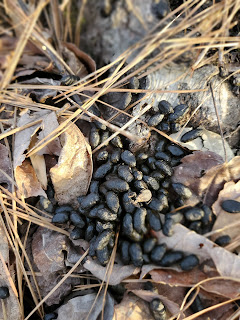Wearing our hunters' orange during a recent scouting excursion, we made our way down a clay trail at a nearby Wildlife Management Area. We were pleased to see many fresh deer prints meaning a number of deer had taken the trail as well. It had rained within the past few days, and we both noticed the light impression of a fair-size hoof that had made a pretty heart shape. Most of the deer prints were deeper holes in the soft clay.
As we hadn't been on that particular trail since early last spring, the mid-winter vegetation stuck us as quite different. The forest is always changing, not only from season to season, but day to day. It was unseasonably warm that day, and the birds were calling and singing as if was spring. I had shivered outdoors just a few days before. Now I was sweating, but also enjoying how my wet clothes had cooled me down.
We the heard the mysterious, repetitious call of what we have been calling a "monkey bird." To our ears it sounded like the cry of a monkey, which we knew isn't native to Alabama. After our foray, Steve looked the call up, and we learned that it had been made by a turkey hen. We often hear other types of turkey calls we do recognize. Now we'll know that one as well.
Other deer sign we watch for are "rubs" made by bucks rubbing their antlers repeatedly on tree bark and "scrapes" made by bucks pawing the ground under a low branch to leave their scent. It seems like the more we scout, the more sign we see. Though I admit "Game Eye" Steve almost always sees it first. He is just naturally more observant than I am, and I feel grateful to have him along to point out much more sign than I would probably ever see by myself. I am getting better, however, and I'm noticing more in the woods and even in my neighborhood. I often see hawks. I spy cats prowling ever so slowly through the bushes of our backyard as they eye our songbirds, squirrels and chipmunks.
During our recent scouting expedition we were especially interested in coming across turkey sign because it won't be long before turkey season. Hunting turkey successfully is one of the most challenging skills for hunters. We would be thrilled just to catch sight of one while hunting. We did see some sign that looked like it might be turkey scratching. According to those in the know, turkey scratching can be identified by its rough V-shape flaring out in the direction the turkey is traveling. Not 100 percent sure if the disturbance in the leaves at the left are from turkeys. Maybe! For sure it does look like it was made by some type of wildlife. Close by we saw several other similar patches of dirt surrounded by leaves. The patches were heading in the same direction.
When I was much younger, I had the good fortune to be able to visit Kenya on a writing and photography assignment. I and the rest of my group came under the tutelage of a British guide named Squack. He schooled us on the various type of sign we were seeing while walking in the Laikipia Highlands and then in the Maasai Mara. His accent made us all feel we were taking part in a National Geographic special. He easily observed and pointed out various types of scat and animal prints. Impressed, I was sure one could only learn to detect animal sign through years of training. I wished I too could track wild animals.
Luckily scouting wildlife sign is much more doable than I ever thought. And for me, it's just as exciting finding sign here in Alabama as it was in Africa. Perhaps more, because I can return to it here again and again. We've found scouting doesn't have to be done on hunting land. Just for the fun of it, my husband and I scout the hiking trails we traverse, including urban trails and state parks.
Once you start looking for sign, you will see both it and wildlife more often. Happy scouting!
Photos by Kathy Hagood



